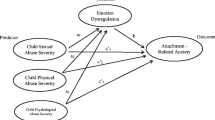Abstract
Attachment anxiety and avoidance have been shown to affect how an individual processes social information such as facial expressions. Previous work has not explored perception of couple relationships. The current study had 39 individuals observe images and videos of couples in conflict. Results suggest that individuals with higher attachment anxiety perceived more intensity in negative interactions/affect and less positive interactions/affect in the couples they observed. Implications for therapy, clinical supervision, and family life education are discussed.

Similar content being viewed by others
References
Baldwin, M. W. (1992). Relational schemas and the processing of social information. Psychological Bulletin, 112(3), 461–484.
Bartholomew, K. (1990). Avoidance of intimacy: An attachment perspective. Journal of Social and Personal Relationships, 7(2), 147–178. doi:10.1177/0265407590072001.
Bartholomew, K., & Horowitz, L. M. (1991). Attachment styles among young adults: A test of a four-category model. Journal of Personality and Social Psychology, 61(2), 226–244. doi:10.1037/0022-3514.61.2.226.
Bowlby, J. (1969). Attachment: Attachment and loss (vol. 1). London: Hogarth.
Bowlby, J. (1973). Attachment and loss: Separation (Vol. 2). New York: Basic Books.
Bowlby, J. (1980). Attachment and loss: Vol. III. Loss. New York: Basic Book Inc., Publishers.
Bowlby, J. (1982). Attachment and loss (Second ed. Vol. I). New York: Basic Books.
Busby, D. M., Crane, D. R., Larson, J. H., & Christensen, C. (1995). A revision of the dyadic adjustment scale for use with distressed and nondistressed couples: Construct hierarchy and multidimensional scales. Journal of Marital and Family Therapy, 21(3), 289–308.
Chen, S., Boucher, H. C., & Tapias, M. P. (2006). The relational self revealed: Integrative conceptualization and implications for interpersonal life. Psychological Bulletin, 132(2), 151–179. doi:10.1037/0033-2909.132.2.151.
Cooper, R. M., Rowe, A. C., Penton-Voak, I. S., & Ludwig, C. (2009). No reliable effects of emotional facial expression, adult attachment orientation, or anxiety on the allocation of visual attention in the spatial cueing paradigm. Journal of Research in Personality, 43(4), 643–652. doi:10.1016/j.jrp.2009.03.005.
Dewitte, M., & De Houwer, J. (2008). Adult attachment and attention to positive and negative emotional face expressions. Journal of Research in Personality, 42(2), 498–505. doi:10.1016/j.jrp.2007.07.010.
Dykas, M. J., & Cassidy, J. (2011). Attachment and the processing of social information across the life span: Theory and evidence. Psychological Bulletin, 137(1), 19–46. doi:10.1037/a0021367.
Edelstein, R. S., & Gillath, O. (2008). Avoiding interference: Adult attachment and emotional processing biases. Personality and Social Psychology Bulletin, 34(2), 171–181. doi:10.1177/0146167207310024.
Fraley, R. C., Waller, N. G., & Brennan, K. A. (2000). An item response theory analysis of self-report measures of adult attachment. Journal of Personality and Social Psychology, 78(2), 350–365. doi:10.1037/0022-3514.78.2.350.
Gottman, J. M., McCoy, K., Coan, J., & Collier, H. (1995). The specific affect coding system (SPAFF) for observing emotional communication in marital and family interaction. Mahwah, NJ: Erlbaum.
Hazan, C., & Shaver, P. (1987). Romantic love conceptualized as an attachment process. Journal of Personality and Social Psychology, 52(3), 511.
Hesse, E. (2008). The Adult Attachment Interview: Protocol, method of analysis, and empirical studies. In J. Cassidy & P. R. Shaver (Eds.), Handbook of attachment: Theory, research, and clinical applications (2nd ed., pp. 552–598). New York, NY, USA: Guilford Press.
Langer, E. J. (2009). Counter clockwise: Mindful health and the power of possibility. New York, NY: Ballantine Books.
Maier, M. A., Bernier, A., Pekrun, R., Zimmermann, P., Strasser, K., & Grossmann, K. E. (2005). Attachment state of mind and perceptual processing of emotional stimuli. Attachment & Human Development, 7(1), 67–81. doi:10.1080/14616730500039606.
Markman, H. J., & Rhoades, G. K. (2012). Relationship education research: Current status and future directions. Journal of Marital and Family Therapy, 38(1), 169–200.
Mikulincer, M., & Shaver, P. R. (2008). Adult attachment and affect regulation. In J. Cassidy & P. R. Shaver (Eds.), Handbook of attachment: Theory, research, and clinical applications (2nd ed., pp. 503–531). New York, NY, USA: Guilford Press.
Mikulincer, M., Shaver, P. R., Sapir-Lavid, Y., & Avihou-Kanza, N. (2009). What’s inside the minds of securely and insecurely attached people? The secure-base script and its associations with attachment-style dimensions. Journal of Personality and Social Psychology, 97(4), 615–633. doi:10.1037/a0015649.
Niedenthal, P. M., Brauer, M., Robin, L., & Innes-Ker, Å. H. (2002). Adult attachment and the perception of facial expression of emotion. Journal of Personality and Social Psychology, 82(3), 419–433. doi:10.1037/0022-3514.82.3.419.
Silva, C., Soares, I., & Esteves, F. (2012). Attachment insecurity and strategies for regulation: When emotion triggers attention. Scandinavian Journal of Psychology, 53, 9–16.
Simpson, J. A., & Belsky, J. (2008). Attachment theory within a modern evolutionary framework. In J. Cassidy & P. R. Shaver (Eds.), Handbook of attachment: Theory, research, and clinical applications (2nd ed., pp. 131–157). New York, NY, USA: Guilford Press.
Suslow, T., Dannlowski, U., Arolt, V., & Ohrmann, P. (2010). Adult attachment avoidance and automatic affective response to sad facial expressions. Australian Journal of Psychology, 62(4), 181–187. doi:10.1080/00049530903567203.
Waldinger, R. J., Schulz, M. S., Hauser, S. T., Allen, J. P., & Crowell, J. A. (2004). Reading others’ emotions: The role of intuitive judgments in predicting marital satisfaction, quality, and stability. Journal of Family Psychology, 18(1), 58–71.
Werner-Wilson, R. J., Lianekhammy, J., Frey, L., Parker, T., Wood, N., et al. (2011). Alpha asymmetry in female military spouses. Journal of Feminist Family Therapy, 23, 202–217.
Author information
Authors and Affiliations
Corresponding author
Rights and permissions
About this article
Cite this article
Wood, N.D., Werner-Wilson, R.J., Parker, T.S. et al. Exploring the Impact of Attachment Anxiety and Avoidance on the Perception of Couple Conflict. Contemp Fam Ther 34, 416–428 (2012). https://doi.org/10.1007/s10591-012-9202-x
Published:
Issue Date:
DOI: https://doi.org/10.1007/s10591-012-9202-x




